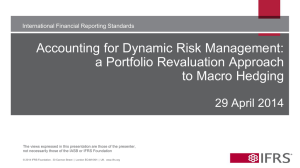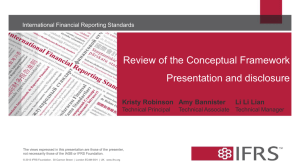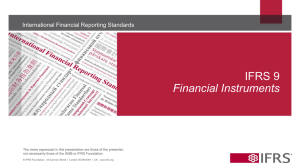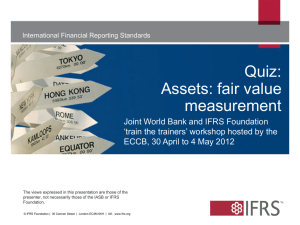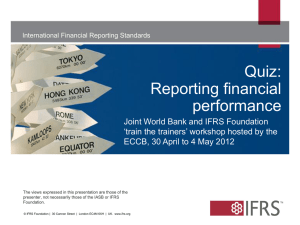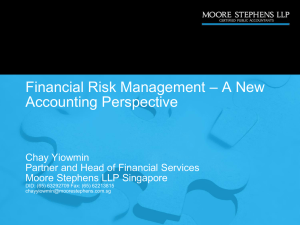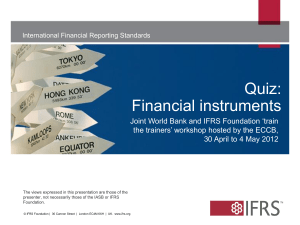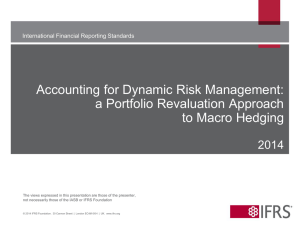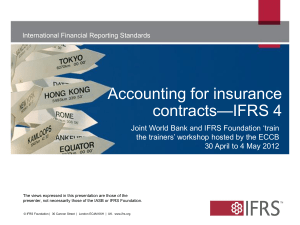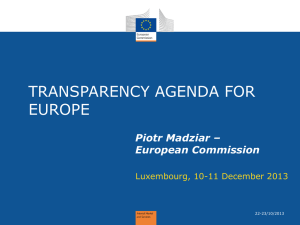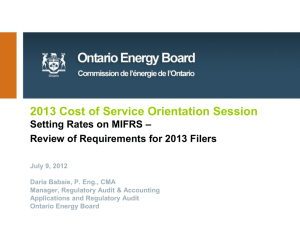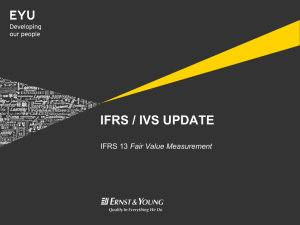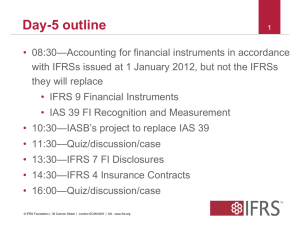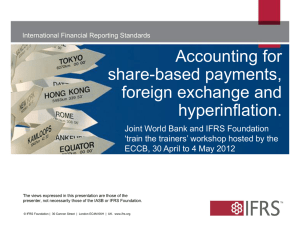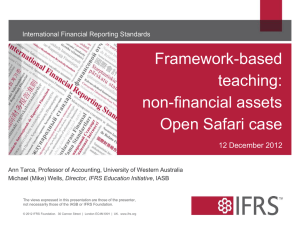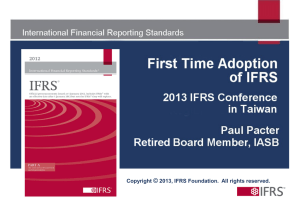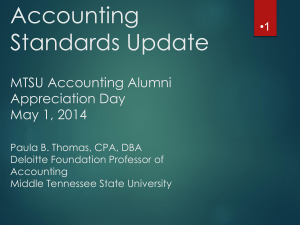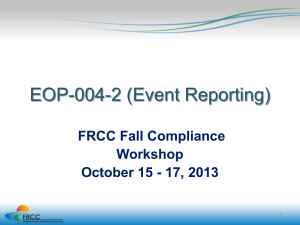Quiz: Business combinations and consolidated financial
advertisement
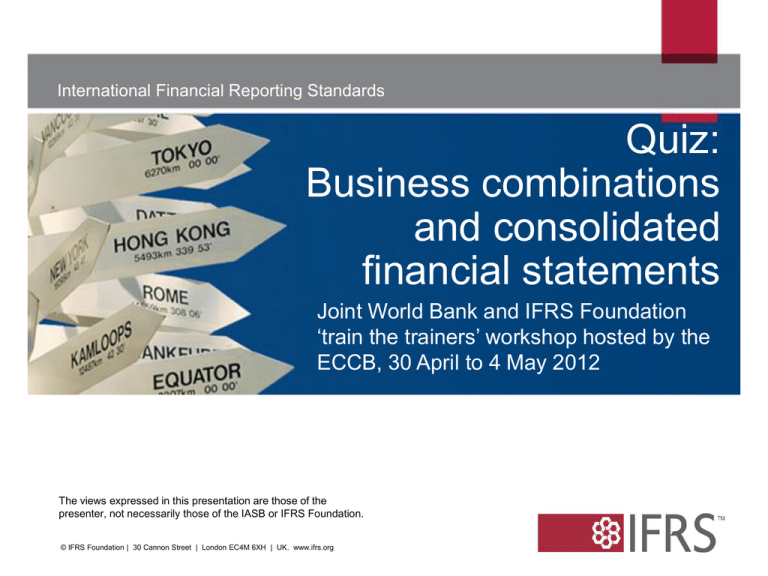
International Financial Reporting Standards Quiz: Business combinations and consolidated financial statements Joint World Bank and IFRS Foundation ‘train the trainers’ workshop hosted by the ECCB, 30 April to 4 May 2012 The views expressed in this presentation are those of the presenter, not necessarily those of the IASB or IFRS Foundation. © IFRS Foundation | 30 Cannon Street | London EC4M 6XH | UK. www.ifrs.org Quiz: Business combinations 2 Question 1: Entity A owns a 60 per cent voting interest in Entity B. Entity B owns a 70 per cent voting interest in Entity C. How should Entity A account for its investment in Entity C in its consolidated financial statements? a. consolidate Entity C. b. account for investment in Entity C using the equity method. c. account for its investment in Entity C using the policy it has adopted to account for associates © IFRS Foundation | 30 Cannon Street | London EC4M 6XH | UK. www.ifrs.org Quiz: Business combinations 3 Question 1: Entity A owns a 60 per cent voting interest in Entity B. Entity B owns a 70 per cent voting interest in Entity C. How should Entity A account for its investment in Entity C in its consolidated financial statements? a. consolidate Entity C. Note confusion is because A effective interest is 42%, but it has control b. account for investment in Entity C using the equity method. c. account for its investment in Entity C using the policy it has adopted to account for associates © IFRS Foundation | 30 Cannon Street | London EC4M 6XH | UK. www.ifrs.org Quiz: Business combinations 4 Question 2: The facts are the same as those in Question 1. Determine the appropriate percentage for the attribution of postacquisition increases in Entity C’s equity to Entity A. a. 70 per cent. b. 60 per cent. c. 42 per cent. © IFRS Foundation | 30 Cannon Street | London EC4M 6XH | UK. www.ifrs.org Quiz: Business combinations 5 Question 2: The facts are the same as those in Question 1. Determine the appropriate percentage for the attribution of postacquisition increases in Entity C’s equity to Entity A. a. 70 per cent. b. 60 per cent. c. 42 per cent. © IFRS Foundation | 30 Cannon Street | London EC4M 6XH | UK. www.ifrs.org Quiz: Business combinations 6 Question 3: Does investor A have control? An investor holds 48% of the equity (and related voting rights) of an investee. The remaining equity and voting rights are held by numerous other shareholders, none individually holding more than 1% of the voting rights. None of the shareholders has arrangements to consult any of the others or make collective decisions. Decisions about the relevant activities of the investee require the approval of a majority of votes cast at relevant shareholders’ meetings. © IFRS Foundation | 30 Cannon Street | London EC4M 6XH | UK. www.ifrs.org Quiz: Business combinations 7 Question 3 continued: 70% of the voting rights of the investee have been cast at recent relevant shareholder meetings, with the exception of one meeting when 78% of the voting rights were cast. Decisions taken at that meeting included changing the financing arrangements entered into by the investee that could affect future dividend payments to shareholders. There are no other contractual arrangements that would affect the assessment of power. © IFRS Foundation | 30 Cannon Street | London EC4M 6XH | UK. www.ifrs.org Quiz: Business combinations 8 Question 3: Given the level of shareholder participation and considering the size and dispersion of shareholdings, in accordance with IFRS 10, the investor with 48 per cent of the voting rights would conclude that it controls the investee: (i) its rights are sufficient to give it power over the investee (ie it has the practical ability to direct the relevant activities of the investee unilaterally); (ii) it has exposure to variable returns; and (iii) the ability to affect those variable returns through its voting rights. © IFRS Foundation | 30 Cannon Street | London EC4M 6XH | UK. www.ifrs.org Quiz: Business combinations 9 Question 3 continued: In accordance with IFRS 12, there are a number of disclosures that the investor would be required to make to help users understand and evaluate the nature of its relationship with the investee. Those disclosures would include: (i) disclosures about significant judgements it has made in determining that it has control of the investee; and (ii) disclosures about non-controlling interests in the investee (eg summarised financial information about the investee). © IFRS Foundation | 30 Cannon Street | London EC4M 6XH | UK. www.ifrs.org Quiz: Business combinations 10 Question 4: An investment vehicle is created to purchase a portfolio of financial assets, funded by debt and equity instruments issued to a number of investors. The equity tranche is designed to absorb the first losses incurred by the portfolio and to receive residual returns of the investment vehicle. © IFRS Foundation | 30 Cannon Street | London EC4M 6XH | UK. www.ifrs.org Quiz: Business combinations 11 Question 4 continued: Investor A holds 35 per cent of the equity tranche and is also the asset manager, managing the vehicle’s asset portfolio within portfolio guidelines. Managing the fund includes decisions about the selection, acquisition and disposal of the assets within that portfolio’s guidelines and the management upon default of any asset in the portfolio. Investor A also receives market-based fixed and performance-related fees for its asset management services. © IFRS Foundation | 30 Cannon Street | London EC4M 6XH | UK. www.ifrs.org Quiz: Business combinations 12 Question 4: Investor A would, in accordance with IFRS 10, conclude that it controls the investment vehicle and must consolidate it: (i) investor A has the ability to direct the relevant activities; (ii) has rights to variable returns from the performance of the vehicle; and (iii) has the ability to use its power to affect the returns it receives. © IFRS Foundation | 30 Cannon Street | London EC4M 6XH | UK. www.ifrs.org Quiz: Business combinations Question 4 continued: In accordance with IFRS 12, there are a number of disclosures that Investor A must make to help users understand and evaluate the nature of its relationship with the consolidated investment vehicle. © IFRS Foundation | 30 Cannon Street | London EC4M 6XH | UK. www.ifrs.org 13 Quiz: Business combinations 14 Question 5: Fund Manager A has a 45% shareholding in Fund B, which it also manages within defined parameters. The constitution of the fund defines the fund’s purpose and sets out the investment parameters within which the fund manager can invest. The constitution also requires Fund Manager A to act in the best interests of the shareholders. Within the defined parameters, however, the investment manager (Fund Manager A) has discretion about the assets in which Fund B will invest. © IFRS Foundation | 30 Cannon Street | London EC4M 6XH | UK. www.ifrs.org Quiz: Business combinations 15 Question 5: Fund Manager A would, in accordance with IFRS 10, conclude that it controls Fund B because: (i) it has the power to direct Fund B’s relevant activities through directing the investment decisions; (ii) has exposure to variable returns from Fund B; and (iii) can use its power to affect the amount of its returns. © IFRS Foundation | 30 Cannon Street | London EC4M 6XH | UK. www.ifrs.org Quiz: Business combinations 16 Question 5 continued: In accordance with IFRS 12, there are a number of disclosures that Fund Manager A would be required to make to help users understand and evaluate the nature of its relationship with Fund B. In addition, Fund Manager A would need to disclose any significant risks associated with Fund B, including the terms of any contractual arrangements that require it to provide financial support to Fund B. © IFRS Foundation | 30 Cannon Street | London EC4M 6XH | UK. www.ifrs.org Quiz: Business combinations 17 Question 6: Investor A holds 70% of the voting rights of Investee C, with Investor B holding the remaining 30% of the voting rights as well as an option to acquire half of the voting rights of Investor A. The option can be exercised over the next two years but is exercisable at a fixed price that is currently deeply out of the money, and the option is expected to remain out of the money over the course of the three-year period. © IFRS Foundation | 30 Cannon Street | London EC4M 6XH | UK. www.ifrs.org Quiz: Business combinations 18 Question 6: Investors A and B would, in accordance with IFRS 10, look at the purpose and design of the potential voting rights, and their terms and conditions, to assess whether they are substantive. In this case, Investors A and B would conclude that the potential voting rights are not substantive because the exercise price creates a barrier to exercise during the exercise period. Therefore, Investor A would consolidate Investee C because it has the current ability to direct the relevant activities of that investee. © IFRS Foundation | 30 Cannon Street | London EC4M 6XH | UK. www.ifrs.org Quiz: Business combinations 19 Question 6 continued: In accordance with IFRS 12, there are a number of disclosures that Investor A would have to make to help users understand and evaluate the nature of its relationship with Investee C. Those disclosures would include: (i) disclosures about non-controlling interests in Investee C; and (ii) significant judgements it has made in determining that it controls Investee C, including the terms and conditions of the potential voting rights that Investor B holds. © IFRS Foundation | 30 Cannon Street | London EC4M 6XH | UK. www.ifrs.org Quiz: Business combinations 20 Question 6 continued: In addition, Investor B must make disclosures about its interests in Investee C. Investor B must also make disclosures that would help users to understand the nature and extent of its interest in Investee C and the risks associated with that interest. For example, Investor B would disclose the reasons why it concluded that it does not control Investee C, which may mean disclosing information about the terms and conditions of the potential voting rights it holds. © IFRS Foundation | 30 Cannon Street | London EC4M 6XH | UK. www.ifrs.org Quiz: Business combinations 21 Question 7: On 1/1/20X1 A has 100 issued voting shares. On 2/1/20X1 A acquires 100% of B from B’s shareholders in exchange for 150 A voting shares. Who is the acquirer in this business combination? a. A? b. B? c. Neither A nor B? © IFRS Foundation | 30 Cannon Street | London EC4M 6XH | UK. www.ifrs.org Quiz: Business combinations 22 Question 7: On 1/1/20X1 A has 100 issued voting shares. On 2/1/20X1 A acquires 100% of B from B’s shareholders in exchange for 150 A voting shares. Who is the acquirer in this business combination? a. A? b. B? B’s shareholders now own 60% of the combined entity. A’s shareholders own 40% of the combined entity c. Neither A nor B? © IFRS Foundation | 30 Cannon Street | London EC4M 6XH | UK. www.ifrs.org Quiz: Business combinations 23 Question 8: A & B transfer their businesses to Z. In return A & B each receive 50% of the voting shares in Z. A & B each appoint 3 members to Z’s 6 member board of directors. A also appoints the chairman of Z. The chairman has a casting vote. Who is the acquirer? a. A? b. B? c. Neither A nor B? © IFRS Foundation | 30 Cannon Street | London EC4M 6XH | UK. www.ifrs.org Quiz: Business combinations 24 Question 8: A & B transfer their businesses to Z. In return A & B each receive 50% of the voting shares in Z. A & B each appoint 3 members to Z’s 6 member board of directors. A also appoints the chairman of Z. The chairman has a casting vote. Who is the acquirer? a. A? The casting vote means that A will ultimately control the assets of Z b. B? c. Neither A nor B? © IFRS Foundation | 30 Cannon Street | London EC4M 6XH | UK. www.ifrs.org Questions or comments? Expressions of individual views by members of the IASB and its staff are encouraged. The views expressed in this presentation are those of the presenter. Official positions of the IASB on accounting matters are determined only after extensive due process and deliberation. © IFRS Foundation | 30 Cannon Street | London EC4M 6XH | UK. www.ifrs.org 25 26 The requirements are set out in International Financial Reporting Standards (IFRSs), as issued by the IASB at 1 January 2012 with an effective date after 1 January 2012 but not the IFRSs they will replace. The IFRS Foundation, the authors, the presenters and the publishers do not accept responsibility for loss caused to any person who acts or refrains from acting in reliance on the material in this PowerPoint presentation, whether such loss is caused by negligence or otherwise. © 2011 IFRS Foundation | 30 Cannon | London 6XH | EC4M UK. www.ifrs.org © IFRS Foundation | 30Street Cannon StreetEC4M | London 6XH | UK | www.ifrs.org
